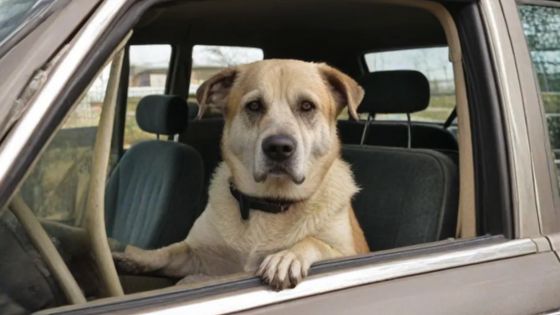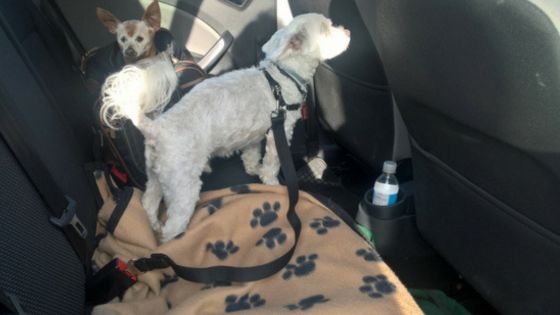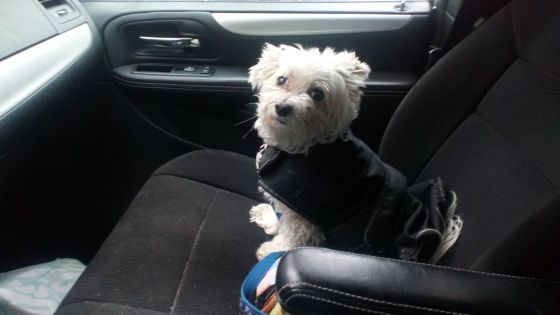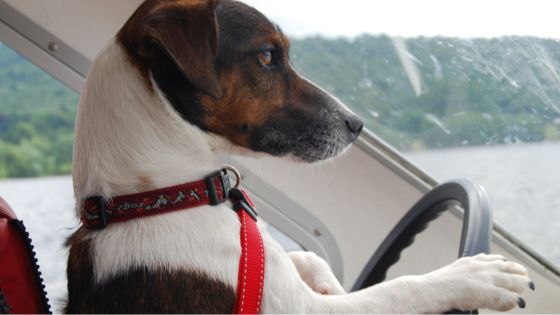Before hitting the open road with your senior dog, some planning is required.
First and most important, please don’t wait until the car is packed to put the dog in and hope for the best. Do you even know if he enjoys car rides?
Keep reading because in this post I’m going to share 7 tips to make your next road trip with the dog as stress free as possible
First Things First, Does Your Dog Like the Car?
If he’s shared much of his life with you, I assume he’s spent at least some time in the car. Does he enjoy it, or would hell be more enjoyable? If you’ve just adopted your senior dog (congratulations by the way!), you may not be sure yet.
If all is fine skip ahead, but if not help starts here.
If you know your dog hates the car (perhaps you know the reason, perhaps you don’t) then my advice to you is – start the training now while there’s still lots of time to prepare.

Preparing Your Pup for the Ride
You can get him used to the car, and hopefully even enjoy a ride using a technique called desensitisation.
What that means is – creating positive associations between one thing and another. In this instance, the use of tasty treats to teach him something really good always happens when he gets in the car.
Obviously I have no idea at what stage your dog is at – is he fine in the car until you’re driving more than a few minutes, or does seeing the car send him screaming into the night?
For the sake of this article, I am going to assume it’s the latter. So… here’s what you do.
▪ Equip yourself with what we call “high value” treats. That would be something he loves, but doesn’t normally get. Turkey, chicken, cheese… something he is allowed to eat, but only gets on the rare occasion. You want to save that kind of treat for when you need to bring out the serious bribery. This next statement is obvious but I am going to mention it anyway – give him very small pieces, you don’t want him gaining weight.
▪ Start at the point where your dog is still fine. For example, I’ll say he’s fine when he sees the car in the driveway, as long as it’s through the window of the house. Great, so while he’s looking out the window at the car give him a treat. The next step is opening the door for him to see the car more clearly (keep him on a leash!). If he’s still fine, give him a treat. Take a step forward, still fine, another treat.
▪ Each of the steps in the above paragraph should be done several times, and don’t advance to the next step unless your dog seems fine.
▪ If the next step you try causes panic, that’s okay – don’t say anything, don’t give him any treats, go back in the house and be cool, like nothing happened.
▪ Try again later, but start from the point where he was still fine, and slow down the speed at which you move from step to step. You may have gone too quickly. Do this all the way until you can get him sitting in a moving car.
You see where I’m going with this? You will eventually get him into the car, but it may take some time. Keep each session short, and try and leave it on a positive note.
If you are a bit unclear as to the process, need some clarification, or have any questions at all, please leave your question below. I would be happy to help.
That’s all fine and dandy, but we’re leaving in two days!
If you are leaving very soon, here are things you can do right away to help:
▪ Start with the desensitisation training anyway – you can’t go wrong with teaching your dog new things!
▪ Check out some dog calming music on YouTube, then play it in the car while on the road. To begin with, play it for him when he is in a relaxed state at home. If he gets used to hearing it when he’s calm, hearing it when he’s anxious should create an association between the music and that wonderfully relaxed state, causing him to settle rather quickly. The one that worked best for my dog is called Through a Dog’s Ear.
▪ Rescue Remedy is a combination of 5 Bach Flower Remedies for anxiety. There is a version for pets, and is typically sold in health food stores and of course online as well. A drop or two in his water, or directly on his food may help. Speak to your vet about it first though.
▪ If your dog has serious anxiety, call your vet immediately to see if he recommends a mild anti-anxiety medication, or natural remedy that might help. Try it before the big day, to see how it affects him.
Ingress and Egress Assistance
My fancy way of asking if your dog needs help getting in and out of the car. Getting a small dog in and out is one thing, but a big one? I don’t know about you, but no way could I lift a lab out of a car, and that’s why we are all grateful for the invention of pet steps and ramps.
If you already use pet steps in the house, see if it can help your dog get in and out of the car. If not, a ramp should do the trick. They come in different styles, sizes and prices. Be aware of the type of surface (you don’t want something that can get slippery when wet), and some have sides to ensure your dog doesn’t fall off.
The next question is – will your dog use it? Let him have a go before you’re packing up the car. If he’s hesitant you can try my trick (well, not mine but something I’ve done that worked) – put a delicious treat at the bottom of the ramp. If he approaches the ramp and eats it no problem, put the next treat a little higher, then the next one a little higher.
If he hesitates at any time, leave it and try again later. Start at the bottom again, and very slowly work your way up. More effective if you keep all training sessions short.
If you’re running out of time, and he’s not yet ready to use the ramp, get some help putting him in the car. Bring the ramp with you and practice on the trip.
One other point to mention – if you have been allowing your dog to jump out of the car as soon as the door opens, you might want to stop that. It could be dangerous, especially on a road trip. Teach him to “wait” when the door opens, only allowing him to jump out on your command. It’s a good idea to put a leash on him before letting him out, you don’t want him taking off after a squirrel and getting lost or hurt.

Ensuring Your Dog’s Safety and Comfort
When hitting the road with your canine companion, it is essential to prioritize their safety and comfort. It’s not safe to let your dog have free run of the car, and that goes for dogs of any size. He could not only hurt himself, but he could distract the driver enough to cause a serious accident.
Even if he is perfectly behaved and sits still better than your kids, it is advisable to restrain him in some away. If you have to brake suddenly or are heaven forbid involved in a fender bender, your dog could get seriously injured. All humans are strapped in for that reason, why not your dog. He is a member of the family!
Investing in a secure pet carrier, harness or seatbelt to restrain your dog during the journey will reduce the risk of injury for everyone. It’s also a legal requirement in many places!
Before You Set Off
Feed your dog before you go, but make it a light meal at least three hours before you leave. You don’t want him getting sick in the car.
Packing Essentials for Your Pup
Just like us, dogs have essential items they need while traveling. Here’s a list, and be sure to add things your dog needs that aren’t mentioned here.
- Health and vaccination records, including rabies certificate. Even if you’re staying relatively close to home, you never know when they’ll come in handy.
- Food
- Water supply
- Bowls
- Leash/harness – even if your dog doesn’t typically wear a harness, if he’s a bit skittish and you’re going to a new environment, a harness is a great safety option
- Favorite toys
- Treats
- Bed/blanket
- Anything else your dog really loves
- Your dog should be microchipped, wear a collar with a tag and both should have up to date contact information. In the unlikely event he goes missing, you want to make sure you do everything you can to ensure his safe return. An up to date photo isn’t a bad idea to have either.
Making Pit Stops for Potty Breaks and Stretching
- Keep your dog hydrated throughout the journey, particularly if you are travelling in warm weather and don’t have air conditioning.
- Stop often enough to allow your dog to take care of business, and get some exercise. If your senior is peeing more often than he used to, take that into consideration. You may need to make a few quick pee stops in addition to your scheduled breaks.
- You might be stopping in a busy area, so don’t let your dog out of the car on the traffic side.
- Designated rest stops have plenty of light from gas stations and restaurants if your journey is taking you through the night. If you pull over in a dark area, put a high viz vest on your dog so you and others can easily see him. A flashing dog collar, light up leash and flashlight are a great way to make your dog and you as visible as possible.
- When stopping for a break for the humans in your group, never leave the dog alone in the car, even if you think it will only be for a few minutes. It won’t take long for your dog to suffer heatstroke and die in hot weather, or freeze to death in cold. You also never know who spots him alone and snatches him.
- Dogs have very sensitive hearing, so don’t blast the radio or movie player.

Calming Anxiety and Motion Sickness
Some dogs may experience anxiety or motion sickness while traveling in a car. To help alleviate these issues, consider using calming products such as pheromone sprays or anxiety vests such as the Thundershirt. Additionally, consult your veterinarian for safe and effective anti-nausea medications for your furry travel companion.
If your dog experiences anxiety in other situations as well, I suggest reading this article for tips – “22 Natural Ways to Calm Your Anxious Dog“
Enjoying the Journey Together
Taking your dog on a car trip can be a rewarding experience for both you and your pet. By adequately preparing and prioritizing your dog’s safety and comfort, you can create lasting memories while exploring new destinations together. Remember to cherish the moments shared on the road and make the most of your adventures with your loyal four-legged friend by your side.
If you’ve taken car trips with your senior, what did you do to prepare? Is there anything you wish you knew before you started? Sharing helps others so please leave your comments below.
I’m excited to announce my new Senior Dog Care Support Service
I offer 1:1 support on everything from health & wellness advice and training tips, to preparing to say goodbye and grief counselling. You can find details on all the packages I offer by visiting the Senior Dog Care Support Service page. If you have any questions or would like to book your FREE 15 minute chat, please email hpearson141@gmail.com
I’ve been rescuing and caring for senior dogs since 2009. From vision and hearing loss to obesity, dementia, kidney disease, liver issues, cardiac problems, Cushing’s, mobility challenges and more, you could say I’ve dealt with and learned a lot! In addition to my hands on experience, I’ve taken many courses and earned several qualifications to keep learning how to help senior dogs and they include: Senior Dog Enrichment, Understanding Canine Anxiety, Care of the Senior Pet and I’m a Certified Pet Loss Specialist.

